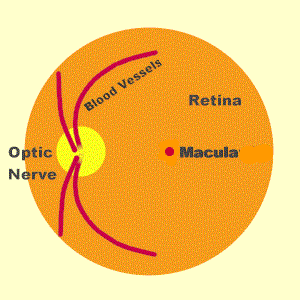![]()
![]()
Retina Basics
|
It is where the curtain where the light falls. The retina extends from Ora serrata in front to the optic nerve at the back. It lines the inner curve of the eye. It has 10 layers. The retina contains the rods and the cones. These are the specialized nerve cells, which are responsible for converting the light energy to chemical energy. This transmits a signal, to other nerve cells, which are like cables. They form the optic nerve that goes to the brain. Thus light is 'sensed'. The rods contain chemical pigment called 'rhodopsin'. There are 120 million rods in our retina. Rods are responsible for vision in dim light. The cones contain 'iodopsin'. There are 7 million cones. They are responsible for vision in bright light and for colour vision. The rhodopsin contains Vit.A. Thus Vit.A is the very essence of vision. When the eye is observed through an ophthalmoscope, this is what one sees. Though the retina is transparent, it appears orange-red. This is because of the blood vessels in the choroid layer underneath. The yellow-white area in the center is the optic nerve. The central area of maximum visual acuity is called as the 'macula'. In front of the retina is a jelly, called as 'vitreous humor'. Below the retina is the 'choroid' layer. This has the dark pigment and creates a 'dark room' for sharper images on the retina. This has a lot of blood vessels. On the outer side of the choroid is the 'white' coat of the eye- the Sclera. The sclera is a tough protective covering to the delicate inner structures. |
 The retina is to the eye what film is to a camera.
The retina is to the eye what film is to a camera.